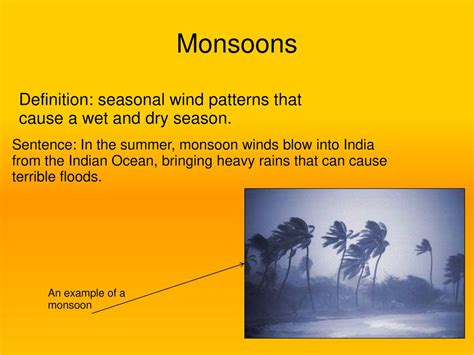Introduction
Monsoon winds, characterized by their seasonal reversal in direction, play a crucial role in shaping the climate of tropical and subtropical regions. Their impact extends far beyond rainfall patterns, influencing agriculture, economies, and human societies worldwide.

Definition of Monsoon Winds
Monsoon winds are seasonal winds that drastically change direction between summer and winter. During the summer months, they blow from the ocean towards the land, bringing heavy rainfall. In winter, they reverse direction and blow from the land towards the ocean, causing drier conditions.
Geographical Distribution of Monsoon Winds
Monsoon winds are predominantly found in tropical and subtropical regions, primarily in the Indian Ocean basin, Southeast Asia, and parts of Africa. Notable monsoon-affected areas include:
- Indian Subcontinent
- Southeast Asia (Thailand, Vietnam, Cambodia, etc.)
- West Africa (Guinea, Senegal, Nigeria, etc.)
- Northern Australia
- Southern China
Causes of Monsoon Winds
Monsoon winds are primarily caused by seasonal shifts in the Earth’s atmospheric pressure and temperature. During the summer, the landmasses heat up faster than the oceans, creating low-pressure areas over the land. This pressure difference draws in moisture-laden winds from the ocean, resulting in heavy rainfall.
In winter, the landmasses cool more rapidly than the oceans, reversing the pressure gradient. High-pressure areas develop over the land, forcing winds to flow outwards towards the cooler, low-pressure oceans. This reversal leads to drier conditions.
Impact of Monsoon Winds on Climate
Monsoon winds have a profound impact on local climates:
- Rainfall Patterns: Monsoon winds determine the seasonal rainfall distribution in many regions. Heavy rainfall during the summer months replenishes water resources and supports agriculture.
- Temperature Regulation: Monsoon winds moderate temperatures, especially during the hot summer months. The moisture they carry reduces peak temperatures and increases humidity.
Economic and Social Impact of Monsoon Winds
Monsoon winds significantly influence economic and social conditions:
- Agriculture: Monsoon rainfall is essential for crop cultivation in many monsoon-affected regions. Favorable rainfall during the summer months supports the growth of rice, soybeans, and other crops.
- Water Resources: Monsoon rains replenish water bodies, ensuring water availability for domestic, agricultural, and industrial uses.
- Transportation: Monsoon winds affect shipping and fishing activities, impacting coastal economies.
Variations and Patterns of Monsoon Winds
Monsoon winds exhibit significant variations in their timing, duration, and intensity. Fluctuations are influenced by factors such as the El Niño-Southern Oscillation (ENSO) and other climate cycles.
El Niño-Southern Oscillation (ENSO): ENSO is a climate phenomenon that involves variations in the temperature of the Pacific Ocean. During El Niño years, warmer than average sea surface temperatures in the eastern Pacific weaken or disrupt monsoon winds, leading to droughts in some regions and floods in others.
Applications of Monsoon Wind Research
Understanding monsoon winds is crucial for:
- Predicting Weather Patterns: Accurate forecasting of monsoon winds helps prepare for extreme weather events such as floods and droughts.
- Agricultural Planning: Farmers can optimize crop planting and water management strategies based on monsoon rainfall predictions.
- Water Resource Management: Governments and water authorities can plan for water storage and distribution based on monsoon patterns.
- Disaster Management: Early warning systems and evacuation plans can be developed based on predictions of monsoon intensity and timing.
Frequently Asked Questions (FAQs)
1. What causes monsoon winds to reverse direction?
Seasonal shifts in atmospheric pressure and temperature create the pressure gradient that drives the change in wind direction.
2. Which regions of the world experience monsoon winds?
Monsoon winds are primarily found in the Indian Ocean basin, Southeast Asia, and parts of Africa.
3. How do monsoon winds impact agriculture?
Monsoon rainfall is essential for crop cultivation in many monsoon-affected regions, supporting the growth of rice, soybeans, and other staple crops.
4. What are the benefits of monsoon winds?
Monsoon winds provide essential rainfall for agriculture, replenish water resources, and moderate temperatures, benefiting local economies and human well-being.
5. What are the challenges associated with monsoon winds?
Monsoon winds can also bring extreme weather events such as floods and droughts, posing challenges to infrastructure, agriculture, and human safety.
6. How is climate change affecting monsoon winds?
Climate change is altering monsoon wind patterns, including changes in timing, duration, and intensity, leading to implications for rainfall patterns and agricultural practices.
7. What research is being done on monsoon winds?
Scientists continue to study monsoon winds to improve forecasting accuracy, understand climate change impacts, and develop adaptation strategies for affected regions.
8. How can I learn more about monsoon winds?
Numerous resources are available online and through scientific journals, providing detailed information on monsoon winds, their causes, and their impact on various aspects of life.
